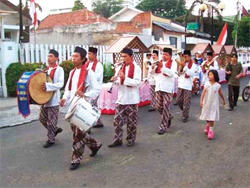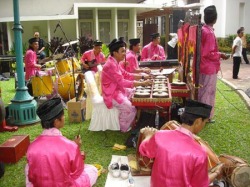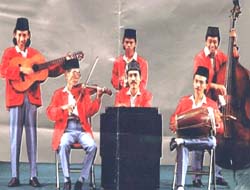Folklore
Dance
Art of dance in Jakarta is a blend of cultural elements in it. At first, the art of dance in Jakarta has Sundanese and Chinese influences, such as dance dancer costume Jaipong with typical Beijing Opera player. But Jakarta could be called the most dynamic regions. In addition to the old dances also appear in the style of dance and choreography is dynamic.
for examples :

Betawi Dance comes from Jakarta. As the capital, Jakarta, often at the center of attention of other regions in Indonesia. In this area, Tribe Betawi born and developed into the native population.
Tribe Betawi itself consists of several ethnic groups who joined in one area so as to form its own culture of the Betawi culture.
Ethnic groups who become citizens betawi are ethnic Arabs, Chinese, Javanese,Malay, Ambon, Bali, and others.
Therefore, the dance betawi much influenced by these ethnic origin. Even so, the dancebetawi has its own characteristics. That is the cheery voice accompaniment music anddance movements are dynamic.
Let's recognize some of the popular dance betawi danced in public.
 Japin dance is actually a dance Zapin. Habit of calling people betawi Z with the letter Jto make a name of this dance is automatically changed into Japin. This dance hasspread everywhere. This dance is getting big influence of Arab culture.
Japin dance is actually a dance Zapin. Habit of calling people betawi Z with the letter Jto make a name of this dance is automatically changed into Japin. This dance hasspread everywhere. This dance is getting big influence of Arab culture.What distinguishes betawi Japin with Zapin dance in general is a musical retinue. Japindance music tracks using betawi like harps. Zapin dance danced by jumping up and down while hitting a small tambourine drum. Hit him even once with a stomping motion.
Seeing this betawi dance to give the feel cheerful. Japin Betawi dance usually in pairsbetween women and men.
The Dance is accompanied by music cokek Gambang Kromong and often displayed inevents held by the Landlord. Therefore, dance and dance clothing cokek somewhatsimilar Betawi dances in China.
As the development period, the landlord is willing to accommodate the live dancers andGambang Kromong cokek was reduced. As a result very few who want to preserve thisbetawi dance.
Dance cokek somewhat similar to ngibing. Another trademark is rocking hip-geal geol.Now cokek players and professional players Kromong Gambang, hard to find.
 Dance betawi long known to the public is TopengBetawi Dance. The Mask DanceBetawi, you can see the three elements of art as well. That dance, theater and music.
Dance betawi long known to the public is TopengBetawi Dance. The Mask DanceBetawi, you can see the three elements of art as well. That dance, theater and music.Mask Dance accompaniment music Betawi lot. Mask Betawi grow and develop on the outskirts of Jakarta. Usually held during a wedding, event and pay vows circumcision.
In Mask Betawi, the dancers wear masks and storytelling lewatseni motion. Now themask dance has a lot dikreasikan Betawi. So Betawi dance became more diverse.
But love of culture and dance betawi, make Wiwik create Lenggang Betawi dancecreations this. In this dance tanjidor can see there is an element and a thick mask danceonce.
Nyai Lenggang Betawi dance tells the story of Nyai Dasima who managed to free them selves from coercion. Nyai Dasima were able to determine the direction andchoices of his life.
Music
In the field of art, for example, the Betawi people have Gambang Kromong art derived from Chinese music arts, but also there Rebana rooted in the tradition of Arab music, Keroncong monument with the Portuguese-Arab background, and Tanjidor the background to the Dutch's. Currently famous for its art Tribe Betawi Lenong, Gambang Kromong, Rebana Tanjidor and Keroncong.
For examples :
TANJIDOR
 Tanjidor adalah sebuah kesenian Betawi yang berbentuk orkes. Kesenian ini sudah dimulai sejak abad ke-19. Alat-alat musik yang digunakan biasanya terdiri dari penggabungan alat-alat musik tiup, alat-alat musik gesek dan alat-alat musik perkusi. Biasanya kesenian ini digunakan untuk mengantar pengantin atau dalam acara pawai daerah.
Tanjidor adalah sebuah kesenian Betawi yang berbentuk orkes. Kesenian ini sudah dimulai sejak abad ke-19. Alat-alat musik yang digunakan biasanya terdiri dari penggabungan alat-alat musik tiup, alat-alat musik gesek dan alat-alat musik perkusi. Biasanya kesenian ini digunakan untuk mengantar pengantin atau dalam acara pawai daerah.
 Gambang keromong (sering pula ditulis gambang kromong) adalah sejenis orkes yang memadukan gamelan dengan alat musik umum. Sebutan gambang keromong diambil dari nama dua buah alat perkusi, yaitu gambang dan keromong. Awal mula terbentuknya orkes gambang keromong tidak lepas dari seorang pimpinan golongan Cina yang bernama Nie Hu-kong.
Gambang keromong (sering pula ditulis gambang kromong) adalah sejenis orkes yang memadukan gamelan dengan alat musik umum. Sebutan gambang keromong diambil dari nama dua buah alat perkusi, yaitu gambang dan keromong. Awal mula terbentuknya orkes gambang keromong tidak lepas dari seorang pimpinan golongan Cina yang bernama Nie Hu-kong.Language of Betawi
Mixed nature of the Betawi dialect is a reflection of the Betawi culture in general, which is the result of mating a variety of cultures, both originating from other areas in the archipelago as well as foreign cultures.
There is also an opinion that the tribes who inhabited the area around Batavia Batavian tribe also classified as early (proto Betawi). Historically, the Kingdom Tarumanagara, based in Sundapura or Sunda Kalapa, had been attacked and conquered by the kingdom of Srivijaya of Sumatra. Therefore, do not be surprised if at the port of Sunda Sundanese ethnic Kalapa, long before the Youth Pledge, already use the Malay language, which is commonly used in Sumatra, which then serve as the national language.
Because of these differences, the language used in the early 20th century, Dutch treat those living around Batavia as different ethnic and call it ethnic Sundanese ethnic Betawi (a word derived from Batavia). However, there are many local names and river names which are preserved in the Sundanese language such as word Ancol, Jewel, Cilandak, Ciliwung, Cideng (which comes from Cihideung and then turned into Cideung and tearkhir be Cideng), and others are still in accordance with the naming described in ancient texts Bujangga Beads which is currently stored in the Bodleian Library, Oxford, England.
Although the formal language used in Jakarta is Indonesian, the language of informal or colloquial language is Indonesian Betawi dialect.
Arts and Culture
Culture Jakarta is a mestizo culture, or a mixture of diverse ethnic cultures. Since the days of the Netherlands, Jakarta is the capital city of Indonesia, which attracted immigrants from within and outside the archipelago. The tribes who inhabit Jakarta, among others, Javanese, Sundanese, Minangkabau, Batak, and the Bugis. Apart from population Nusantara, Jakarta culture also absorb a lot of foreign cultures, such as Arab culture, Chinese, Indian, and Portuguese.
Tribe Betawi as a native of Jakarta somewhat sidelined by the new settlers. They come out of Jakarta and moved to areas in West Java province and provinsiBanten. Betawi culture was eliminated by other cultures both Indonesian and western culture. To preserve Betawi culture, was founded in Situ Babakan cultural heritage.
WATER TOURISM
CULTURAL TOURISM
- Performance of musical and traditional at 2.00-4.00 pm every weekend.(betawi artistic performance at 2.00-4.00 pm every weekend)
- Training of traditional dance and music at 8.00-12.00 am every Wednesday and Sunday
- Training of traditional theatre (lenong)at 2.00-5.00 pm every Thursday.
- Excercises of silat beksi every Tuesday and Sunday evening.
- Performance arts on moslem new year.P
- Performance arts on december weekend
- The role of art festival betawi legend
- Setu babakan attractions.
- Traditional home industry such as;bir pletok,kerak telor,laksa,toge goreng,dodol,geplak,etc.
- other traditional people’s activities such as; farming, netting, fishing, freshwater fish farming etc


















